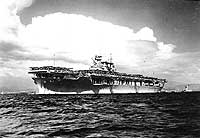
USS Yorktown, a 19,800 ton aircraft carrier built at Newport News, Virginia, was commissioned on 30 September 1937. Operating in the Atlantic and Caribbean areas until April 1939, she then spent the next two years in the Pacific. In May 1941 Yorktown returned to the Atlantic, patrolling actively during the troubled months preceding the outbreak of war between the United States and the Axis powers.
Two weeks after the 7 December 1941 Japanese attack on Pearl Harbor, Yorktown transited the Panama Canal to reinforce the badly damaged Pacific Fleet. The carrier's first combat operation was the Marshalls-Gilberts raid in early February 1942. Yorktown then steamed to the South Pacific, where she participated in a series of raids and other operations that climaxed in the Battle of Coral Sea in early May. In this action, in which she was damaged by enemy bombs, her planes attacked two Japanese aircraft carriers, helping to sink Shoho and damaging Shokaku.
Quick repairs at Pearl Harbor put Yorktown into good enough condition to participate in the Battle of Midway on 4-6 June 1942. During this great turning point of the Pacific War, her air group fatally damaged the Japanese aircraft carrier Soryu and shared in the destruction of the carrier Hiryu and cruiser Mikuma. However, successive strikes by dive bombers and torpedo planes from Hiryu seriously damaged Yorktown, causing her abandonment during the afternoon of 4 June. Two days later, while salvage efforts were underway, the Japanese submarine I-168 torpedoed both the damaged carrier and the destroyer Hammann, sinking the latter immediately and Yorktown shortly after daybreak on 7 June 1942. USS Yorktown's wreck was discovered and examined in May 1998, in surprisingly good condition after fifty-six years beneath more than three miles of sea water.
This page features a special selection of images concerning USS Yorktown (CV-5), chosen from the more extensive coverage referenced in the links provided below.
For more comprehensive picture coverage on this ship, her crew and activities, see:
| If you want higher resolution reproductions than the digital images presented here, see: "How to Obtain Photographic Reproductions." |
Click on the small photograph to prompt a larger view of the same image.
|
Photo #: NH 42341 USS Yorktown (CV-5) Photographed during builder's trials, May 1937. U.S. Naval History and Heritage Command Photograph. Online Image: 87KB; 740 x 565 pixels |
 |
|
Photo #: NH 50330 USS Yorktown (CV-5) Anchored in Hampton Roads, Virginia, 30 October 1937. U.S. Naval History and Heritage Command Photograph. Online Image: 100KB; 740 x 585 pixels |
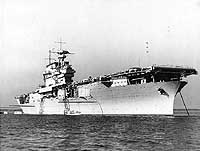 |
|
Photo #: 80-G-5132 USS Yorktown (CV-5) Anchored in a Haitian harbor, circa 1938-40. Official U.S. Navy Photograph, now in the collections of the U.S. National Archives. Online Image: 100KB; 740 x 535 pixels Reproductions of this image may also be available through the National Archives photographic reproduction system. |
 |
|
Photo #: 80-G-640553 USS Yorktown (CV-5), Operating in the vicinity of the Coral Sea, April 1942. Photographed from a TBD-1 torpedo plane that has just taken off from her deck. Other TBD and SBD aircraft are also ready to be launched. A F4F-3 "Wildcat" fighter is parked on the outrigger just forward of the island. Other ships in company include a fleet oiler, a destroyer and a heavy cruiser. This view has been retouched to censor the radar antenna mounted atop Yorktown's foremast. Official U.S. Navy Photograph, now in the collections of the U.S. National Archives. Online Image: 123KB; 740 x 600 pixels Reproductions of this image may also be available through the National Archives photographic reproduction system. |
 |
|
Photo #: NH 95571 USS Yorktown (CV-5) Bombing Squadron Five (VB-5) SBD-3 aircraft spotted forward on the flight deck, during operations in the Coral Sea, April 1942. VB-5 painted individual plane numbers on the engine cowling, as seen here. Scouting Squadron Five (VS-5) planes had the numbers on the wing leading edge. Courtesy of the U.S. Naval Institute, 1984. U.S. Naval History and Heritage Command Photograph. Online Image: 106KB; 740 x 615 pixels |
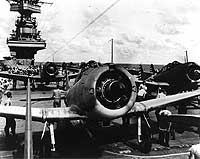 |
|
Photo #: 80-G-13065 USS Yorktown (CV-5) In Dry Dock # 1 at the Pearl Harbor Navy Yard, 29 May 1942, receiving urgent repairs for damage received in the Battle of Coral Sea. She left Pearl Harbor the next day to participate in the Battle of Midway. USS West Virginia (BB-48), sunk in the 7 December 1941 Japanese air attack, is being salvaged in the left distance. Official U.S. Navy Photograph, now in the collections of the U.S. National Archives. Online Image: 88KB; 740 x 620 pixels Reproductions of this image may also be available through the National Archives photographic reproduction system. |
 |
|
Photo #: 80-G-312018 Battle of Midway, June 1942 Scene on board USS Yorktown (CV-5), shortly after she was hit by three Japanese bombs on 4 June 1942. Dense smoke is from fires in her uptakes, caused by a bomb that punctured them and knocked out her boilers. Taken by Photographer 2rd Class William G. Roy from the starboard side of the flight deck, just in front of the forward 5"/38 gun gallery. Man with hammer at right is probably covering a bomb entry hole in the forward elevator. Note arresting gear cables and forward palisade elements on the flight deck; CXAM radar antenna, large national ensign and YE homing beacon antenna atop the foremast; 5"/38, .50 caliber and 1.1" guns manned and ready at left. This view forms a panorama with Photo # 80-G-312019. Official U.S. Navy Photograph, now in the collections of the U.S. National Archives. Online Image: 119KB; 700 x 645 pixels Reproductions of this image may also be available through the National Archives photographic reproduction system. |
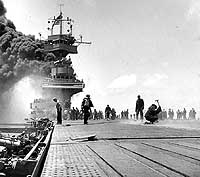 |
|
Photo #: 80-G-414423 Battle of Midway, June 1942 USS Yorktown (CV-5) is hit on the port side, amidships, by a Japanese Type 91 aerial torpedo during the mid-afternoon attack by planes from the carrier Hiryu, 4 June 1942. Photographed from USS Pensacola (CA-24). Yorktown is heeling to port and is seen at a different aspect than in other views taken by Pensacola, indicating that this is the second of the two torpedo hits she received. Note very heavy anti-aircraft fire. Official U.S. Navy Photograph, now in the collections of the U.S. National Archives. Online Image: 87KB; 740 x 620 pixels Reproductions of this image may also be available through the National Archives photographic reproduction system. |
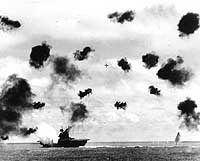 |
|
Photo #: 80-G-17061 Battle of Midway, June 1942 USS Yorktown (CV-5) being abandoned by her crew after she was hit by two Japanese Type 91 aerial torpedoes, 4 June 1942. USS Balch (DD-363) is standing by at right. Note oil slick surrounding the damaged carrier, and inflatable life raft being deployed off her stern. Official U.S. Navy Photograph, now in the collections of the U.S. National Archives. Online Image: 104KB; 740 x 615 pixels Reproductions of this image may also be available through the National Archives photographic reproduction system. |
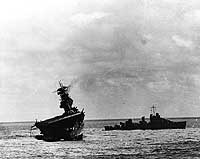 |
For more comprehensive picture coverage on this ship, her crew and activities, see:
NOTES:
| If you want higher resolution reproductions than the digital images presented here, see: "How to Obtain Photographic Reproductions." |
Page made 4 April 1999
Coding updated 4 May 2009